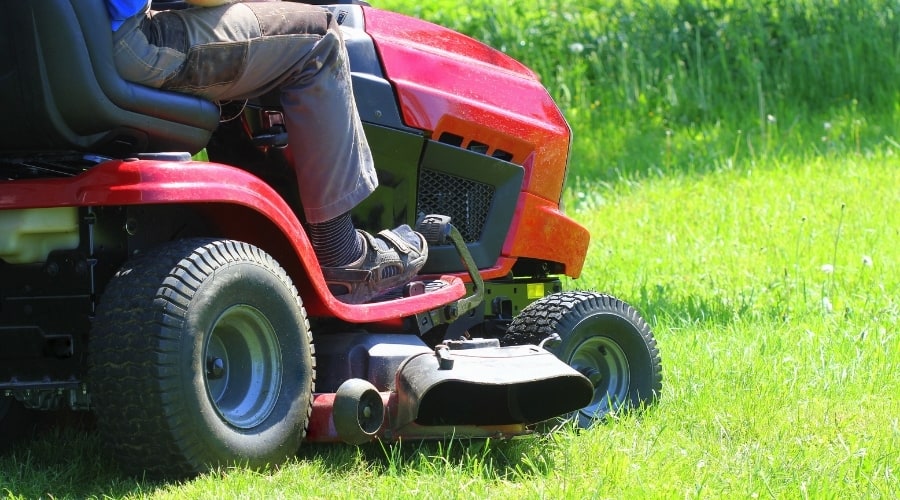Troy Bilt mowers are some of the best available, but they require maintenance to keep running. Taking the time to winterize your mower in autumn will help ensure that your lawn maintenance next spring goes smoother.
In this article, you’ll discover the top five reasons why your Troy Bilt riding mower won’t move. I’ll break it down for you, with easy maintenance and repair steps to keep your yard looking great all year.
The main reason a Troy Bilt riding mower won’t move is because of fuel issues. Whether it is old fuel, using the wrong gas, a dirty fuel filter, or a blocked fuel line, flow within your engine is the key to making your mower move. When your engine can’t move fuel through its system, it won’t move or run.
Table of Contents
Troy Bilt Riding Mower Won’t Move
There’s nothing worse than getting ready to go out and take care of a messy yard only to discover your mower won’t move. Frustration doesn’t cover it.
Worse still, the idea of taking anything apart yourself to fix it can be daunting. Luckily, I can help you troubleshoot the top five reasons why your Troy Bilt Mower won’t move so you can get your lawn back to its ordinarily pristine condition.
1 – Fuel and Air
Your fuel and air system can cause problems with your Troy Bilt Riding mower in several different ways. For example, old or incorrect fuel may not run the engine at all.
Gas inside your mower should always be ‘new,’ which means less than thirty days old.
A fuel filter will usually warn you when there’s a problem. Long before you can’t get your mower to move, you’ll have start and stop issues where the engine dies or runs erratically.
Ensure that you check fuel and oil levels regularly and change your fuel filters as often as the manufacturer recommends for your model, usually after fifty to ninety hours of use.
I recommend watching this video if you don’t know how to change your fuel filter. Though it is specific to the Troy-Bilt TB130, it will still give you a step-by-step visual example of the process.
Replacing clogged fuel lines is usually as simple as draining the engine, popping the line off at both ends, and putting a new one in its place.
You’ll find a small metal clamp at each end, and once you loosen those, it is simple enough to pull the line away. In some cases, you can clear a blockage manually.
Unfortunately, doing this risks leaving debris behind to collect, and then you’ll have the same problem over again.
Gas caps are the easiest to remove and replace. All you need do is quite literally unscrew it and put a new compatible cap in place.
The vents in your gas cap allow air to flow into the engine, so the fuel doesn’t create a vacuum and vapor lock as you work.
2 – Disengaged Parking Break
Any time you stop your Troy Bilt Riding mower, please follow the manufacturer-recommended steps. First, turn off the blades using the PTO, then put your transmission in neutral.
After that, set your parking brake, turn off the engine, and remove your key. If you get in the habit of following this routine, you’ll have fewer moments when your mower won’t move.
For the Troy Bilt Super Bronco, you will need to fully depress the brake pedal and hold it in while you press the parking brake button.
If you forget to hold down the regular brake, the parking brake will not be on the next time you climb on. Other models may use a slightly different system to engage the parking brake, such as pushing down the clutch.
Your owner’s manual will have specific details.
3 – Engaged Blades
You cannot get your Troy Bilt Riding mower to move without disengaging the blades and putting the parking brake on.
While this might seem odd, it’s actually a safety feature to help prevent accidents. If this is the problem, you are in luck because the fix only takes about a minute.
Your PTO lever is what engages the blades. You’ll find it next to the driver’s seat on the right-hand side of the mower’s fender.
Doing this is the only way to tell the engine to send power to those blades. So first, check that it’s off. That should disengage the blades.
Always start with the blades off.
4 – Belts
The drive belt on your Troy Bilt Riding mower does what it sounds like. It drives the engine. As Sears points out, “The ground drive belt connects the engine crankshaft to the transaxle pulley to drive the rear wheels. If the belt breaks, the lawn tractor won’t move.”
A surprising amount of the time, the problem is that a mower has the wrong belt. It’s common to get the wrong size or use a generic but slightly off-width replacement.
Troy Bilt riding mowers need an exact fit. When your wheels don’t turn, try swapping your drive belt for a new MTG belt specific to your model.
You can find the right size by locating your model number. According to Troy Bilt, this is eleven digits long and located on the left side of the Product Identification Label.
Once you have the part, disconnect your spark plug and pull the deck out from under your mower.
To remove and replace this belt, take off the flywheel screen cap. You will need a wrench to hold the engine crankshaft in place while removing the engine pulley bolt and washer.
Then you can release the belt from the pulleys and belt guides. Finally, disconnect and remove the battery so you can get the drive belt off the transaxle pulley.
Putting a new belt on is merely the reverse of this process.
5 – Spark Plug Problems
Your spark plug moves power through your Troy Bilt Riding mower. Without it, nothing moves. Happily, cracked, damaged, or rusted spark plugs are the easiest part to identify and change.
Ensure that your engine is off and the key is not in the ignition, then locate the sparkplug to the left of the valve cover.
Pull the spark plug wire loose, and using a spark plug wrench, remove the plug itself. The tip will often help you identify what went wrong and diagnose more significant issues.
For example, a mechanically damaged tip will be worn down, while a fuel fouled end will be dark and covered in fuel.
Whatever the cause, a broken or nonfunctional spark plug is replaced by putting the new part in place, using your sparkplug wrench for seating it, and then reconnecting the wire.
Helpful Tips To Know Why Troy Bilt Riding Mower Won’t Move
Keeping your yard in good condition is a matter of pride for most homeowners, though it can also be a contractual obligation if you agree to it in a lease. A good riding mower will make quick work of even the most extensive lawns.
Here are more helpful tips to know why a Troy Bilt riding mower won’t move.
- Check your tires. When the engine turns on and idles, the blades engage, and the brakes disengage correctly, you may have a wheel issue. Flat tires will still turn, but a broken axle won’t turn. Sadly, this is probably not a fix you can do at home with minimal tools.
- It is essential to put the right fuel and oil in your riding mower. Running an engine, even for a minute or two, with the wrong fuel or oil can cause it to cease up. Regrettably, that often leads to a complete engine replacement.
- If your engine is flooded, it will also cause your mower not to move. In this case, crank the engine with the throttle in the ‘Fast’ position and don’t give it more gas.
Final Thoughts
It is almost always one of these five fundamental issues when your Troy Bilt Riding mower doesn’t move. Hopefully, now that you know what to look for, it will be easier to troubleshoot your problem.
Most of these fixes require very little mechanical knowledge. You can accomplish them by reading about them here, looking at your owner’s manual, and occasionally watching a pro do it first on a YouTube video.
Getting your mower running again shouldn’t be a headache. You can tackle these fixes at home from a spark plug swap to a gas cap or belt and often still have time to mow the lawn the same day.

